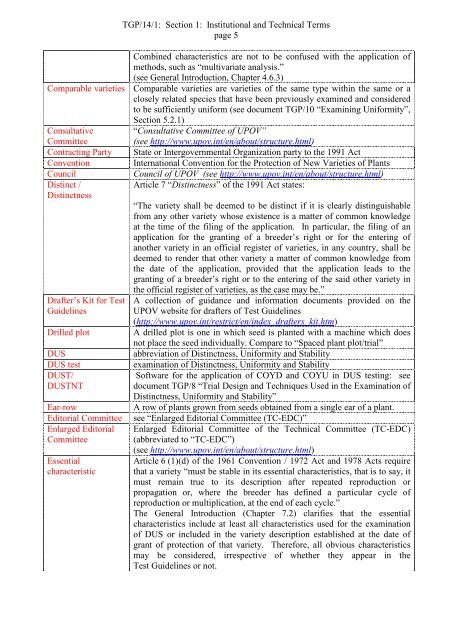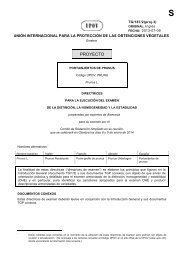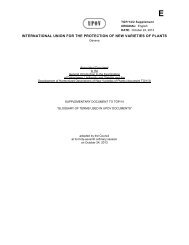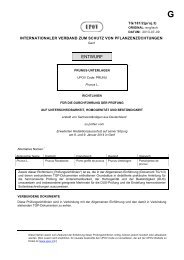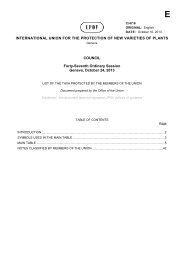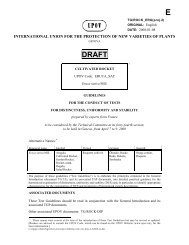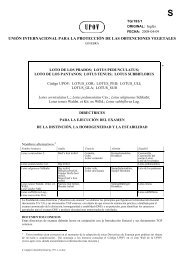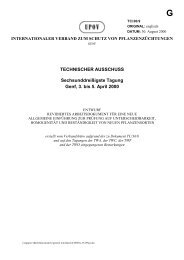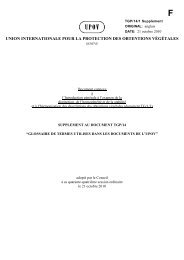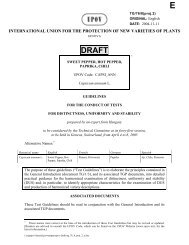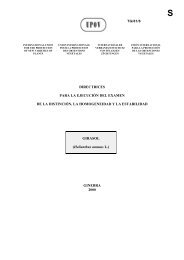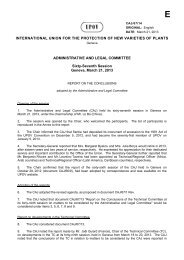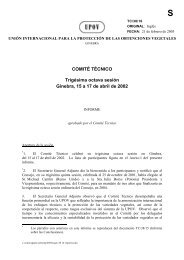E - International Union for the Protection of New Varieties of Plants
E - International Union for the Protection of New Varieties of Plants
E - International Union for the Protection of New Varieties of Plants
Create successful ePaper yourself
Turn your PDF publications into a flip-book with our unique Google optimized e-Paper software.
TGP/14/1: Section 1: Institutional and Technical Terms<br />
page 5<br />
Comparable varieties<br />
Consultative<br />
Committee<br />
Contracting Party<br />
Convention<br />
Council<br />
Distinct /<br />
Distinctness<br />
Drafter’s Kit <strong>for</strong> Test<br />
Guidelines<br />
Drilled plot<br />
DUS<br />
DUS test<br />
DUST/<br />
DUSTNT<br />
Ear-row<br />
Editorial Committee<br />
Enlarged Editorial<br />
Committee<br />
Essential<br />
characteristic<br />
Combined characteristics are not to be confused with <strong>the</strong> application <strong>of</strong><br />
methods, such as “multivariate analysis.”<br />
(see General Introduction, Chapter 4.6.3)<br />
Comparable varieties are varieties <strong>of</strong> <strong>the</strong> same type within <strong>the</strong> same or a<br />
closely related species that have been previously examined and considered<br />
to be sufficiently uni<strong>for</strong>m (see document TGP/10 “Examining Uni<strong>for</strong>mity”,<br />
Section 5.2.1)<br />
“Consultative Committee <strong>of</strong> UPOV”<br />
(see http://www.upov.int/en/about/structure.html)<br />
State or Intergovernmental Organization party to <strong>the</strong> 1991 Act<br />
<strong>International</strong> Convention <strong>for</strong> <strong>the</strong> <strong>Protection</strong> <strong>of</strong> <strong>New</strong> <strong>Varieties</strong> <strong>of</strong> <strong>Plants</strong><br />
Council <strong>of</strong> UPOV (see http://www.upov.int/en/about/structure.html)<br />
Article 7 “Distinctness” <strong>of</strong> <strong>the</strong> 1991 Act states:<br />
“The variety shall be deemed to be distinct if it is clearly distinguishable<br />
from any o<strong>the</strong>r variety whose existence is a matter <strong>of</strong> common knowledge<br />
at <strong>the</strong> time <strong>of</strong> <strong>the</strong> filing <strong>of</strong> <strong>the</strong> application. In particular, <strong>the</strong> filing <strong>of</strong> an<br />
application <strong>for</strong> <strong>the</strong> granting <strong>of</strong> a breeder’s right or <strong>for</strong> <strong>the</strong> entering <strong>of</strong><br />
ano<strong>the</strong>r variety in an <strong>of</strong>ficial register <strong>of</strong> varieties, in any country, shall be<br />
deemed to render that o<strong>the</strong>r variety a matter <strong>of</strong> common knowledge from<br />
<strong>the</strong> date <strong>of</strong> <strong>the</strong> application, provided that <strong>the</strong> application leads to <strong>the</strong><br />
granting <strong>of</strong> a breeder’s right or to <strong>the</strong> entering <strong>of</strong> <strong>the</strong> said o<strong>the</strong>r variety in<br />
<strong>the</strong> <strong>of</strong>ficial register <strong>of</strong> varieties, as <strong>the</strong> case may be.”<br />
A collection <strong>of</strong> guidance and in<strong>for</strong>mation documents provided on <strong>the</strong><br />
UPOV website <strong>for</strong> drafters <strong>of</strong> Test Guidelines<br />
(http://www.upov.int/restrict/en/index_drafters_kit.htm)<br />
A drilled plot is one in which seed is planted with a machine which does<br />
not place <strong>the</strong> seed individually. Compare to “Spaced plant plot/trial”<br />
abbreviation <strong>of</strong> Distinctness, Uni<strong>for</strong>mity and Stability<br />
examination <strong>of</strong> Distinctness, Uni<strong>for</strong>mity and Stability<br />
S<strong>of</strong>tware <strong>for</strong> <strong>the</strong> application <strong>of</strong> COYD and COYU in DUS testing: see<br />
document TGP/8 “Trial Design and Techniques Used in <strong>the</strong> Examination <strong>of</strong><br />
Distinctness, Uni<strong>for</strong>mity and Stability”<br />
A row <strong>of</strong> plants grown from seeds obtained from a single ear <strong>of</strong> a plant.<br />
see “Enlarged Editorial Committee (TC-EDC)”<br />
Enlarged Editorial Committee <strong>of</strong> <strong>the</strong> Technical Committee (TC-EDC)<br />
(abbreviated to “TC-EDC”)<br />
(see http://www.upov.int/en/about/structure.html)<br />
Article 6 (1)(d) <strong>of</strong> <strong>the</strong> 1961 Convention / 1972 Act and 1978 Acts require<br />
that a variety “must be stable in its essential characteristics, that is to say, it<br />
must remain true to its description after repeated reproduction or<br />
propagation or, where <strong>the</strong> breeder has defined a particular cycle <strong>of</strong><br />
reproduction or multiplication, at <strong>the</strong> end <strong>of</strong> each cycle.”<br />
The General Introduction (Chapter 7.2) clarifies that <strong>the</strong> essential<br />
characteristics include at least all characteristics used <strong>for</strong> <strong>the</strong> examination<br />
<strong>of</strong> DUS or included in <strong>the</strong> variety description established at <strong>the</strong> date <strong>of</strong><br />
grant <strong>of</strong> protection <strong>of</strong> that variety. There<strong>for</strong>e, all obvious characteristics<br />
may be considered, irrespective <strong>of</strong> whe<strong>the</strong>r <strong>the</strong>y appear in <strong>the</strong><br />
Test Guidelines or not.


